Telephones
1974 Western Electric 1C1 Rotary Dial Payphone
 I found this very nice example of a 1970's Western Electric payphone for $10 at a yard in September, 2017. It came without a key for the upper housing, where all the telephone circuitry is located. The lower housing, which contains the coin vault and return did not have a lock. The lock had been removed and the coin vault was missing.
I found this very nice example of a 1970's Western Electric payphone for $10 at a yard in September, 2017. It came without a key for the upper housing, where all the telephone circuitry is located. The lower housing, which contains the coin vault and return did not have a lock. The lock had been removed and the coin vault was missing.
Without a key to open the upper housing, there wasn't much I could do with the phone. Western Electric designed these phones to be stronger than a safe, and there is no way to break in without damaging or destroying the phone. So I began a search for the key. Although the lower locks on payphones were each unique, the upper housing locks used the same key with an area code. This was so the telephone service person could service any phone in the area code with a single access key.
Finally, this past March of 2020, I located a key that would open the upper housing from an EBay seller. This particular model doesn't require any special converson to use it on a home telephone line as long as pulse dialing is accepted. But when I connected it to my phone line, I got nothing. Not knowing anything about payphones, I searched online for any information, but there was very little for this model. I had a lot to learn to get this phone working. Fortunately, there are some very excellent folks on the Classic Rotary Telephone Forum.
The first thing I learned is that beginning in the late 1960's, payphones were gradually required to convert to DTF (Dial Tone First) service, so that a person could dial 911 without depositing a coin. To dial a number with more than three digits, a deposit was required. This phone cost twenty cents for a local call. My phone could be set for Pre-Pay service or DTF service. With help from the forum members, I found that the phone was still set for Pre-Pay service. Switching to DTF was just a matter of moving a set of jumpers from PP to DTF on the coin chassis. Or so I thought.
Setting the jumpers to DTF was partially successful. When I connected the phone again, I got a dial tone, and incoming calls could be answered. But I couldn't dial out. Again with help from forum members who provided guidance and copies of diagrams and wiring charts, I found that some of the other wiring in the phone was still set for Pre-Pay. But with the information I received from the forum, I was able to rewire the phone for DTF service, and it now works perfectly. The phone will dial DTF service numbers like 411, 511, or 911 with no deposit required. I can drop a quarter in the phone and make a local call, just like the old days when a payphone could be found on just about every corner. One improvement, though, I have the phone set so that my quarter goes straight to the coin return, so I can use the same quarter over and over. Maybe I should get rid of my cell phone?
1915 Western Electric 20AL Desk Set
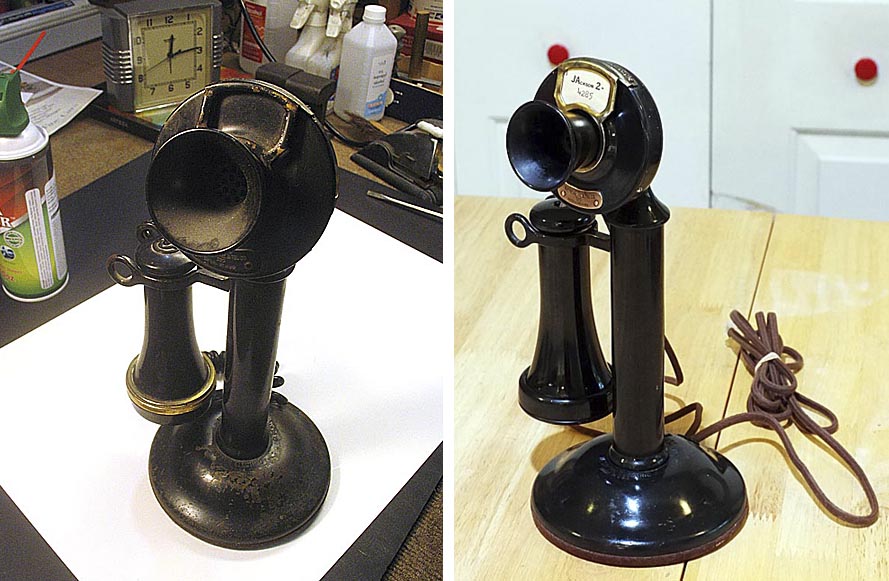 Western Electric introduced the first candlestick styled desk stand telephone sets in 1904. The 20AL model shown here was introduced in 1915. The telephones were made of brass, and beginning around 1910, were painted black. Earlier models were brass or nickel plated.
Western Electric introduced the first candlestick styled desk stand telephone sets in 1904. The 20AL model shown here was introduced in 1915. The telephones were made of brass, and beginning around 1910, were painted black. Earlier models were brass or nickel plated.
The 20AL does not have a ringer or coil, so it had to be connected to a subset to be used. It is possible to connect the 20AL directly to a phone line and receive calls if there is another phone on the line with a ringer and dial. The 20AL used a 323 transmitter and 144 receiver.
I bought my 20AL candlestick from the Goodwill online website. It came with a cheesy receiver from a 1970's era reproduction which I tossed, and replaced it with a proper handset I found on eBay.
The paint on this example was in pretty good condition, except for the base, so I decided to repaint the base, but leave the rest of the paint alone. I masked off the base and painted it black. After the paint dried for several days, I wet sanded the paint with 2000 grit paper, then buffed with 000 steel wool. This smoothed and dulled the paint. I then buffed and polished the base and other parts with Novus #2, which restored a nice luster to the base and other parts. It is very difficult to see any difference between the base and the original paint.
 I decided to leave the dial card holder brass instead of painting it black, so to provide some visual interest to the telephone. I added an original number card I had on hand. I also used a Dremel brush to remove the black paint from the copper builder's place under the mouthpiece, again for some aesthetic appeal.
I decided to leave the dial card holder brass instead of painting it black, so to provide some visual interest to the telephone. I added an original number card I had on hand. I also used a Dremel brush to remove the black paint from the copper builder's place under the mouthpiece, again for some aesthetic appeal.
I wired in the new handset and a new cloth covered line cord with a modular jack to complete the restoration. The telephone can be used as an extension phone, but with no dial or ring capabilities. For fun, I staged an image of the 20AL with an old desk lamp, a old Bulova wrist watch, and some desk accessories.
1935 Western Electric D1/202 Desk Sets
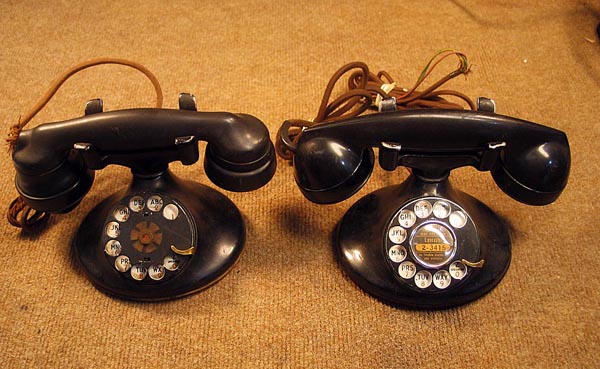 I found these two Western Electric Model 202 desk sets on the Goodwill online auction site. I was lucky enough to win both. The set on the left in the photo at left has an E1 handset and a 4H dial. The 4H dial was the last dial made by Western Electric that had a "clickety-clack" sound as the dial returns to its stop. The set on the right has a 5H dial and F1 handset. Both are correct as Western Electric evolved the various components used in the set, which was produced from about 1928 to the mid-1940's. The sets were re-issued in the 1950's with chrome and gold bases as "designer" sets.
I found these two Western Electric Model 202 desk sets on the Goodwill online auction site. I was lucky enough to win both. The set on the left in the photo at left has an E1 handset and a 4H dial. The 4H dial was the last dial made by Western Electric that had a "clickety-clack" sound as the dial returns to its stop. The set on the right has a 5H dial and F1 handset. Both are correct as Western Electric evolved the various components used in the set, which was produced from about 1928 to the mid-1940's. The sets were re-issued in the 1950's with chrome and gold bases as "designer" sets.
The Model 202 phones did not have a network or ringer inside. Rather, a separate subscriber box, also called a bellbox or subset, which contained the network and ringer, was installed on a wall somewhere away from the desk set. These phones were not designed to be plugged directly into a phone line.
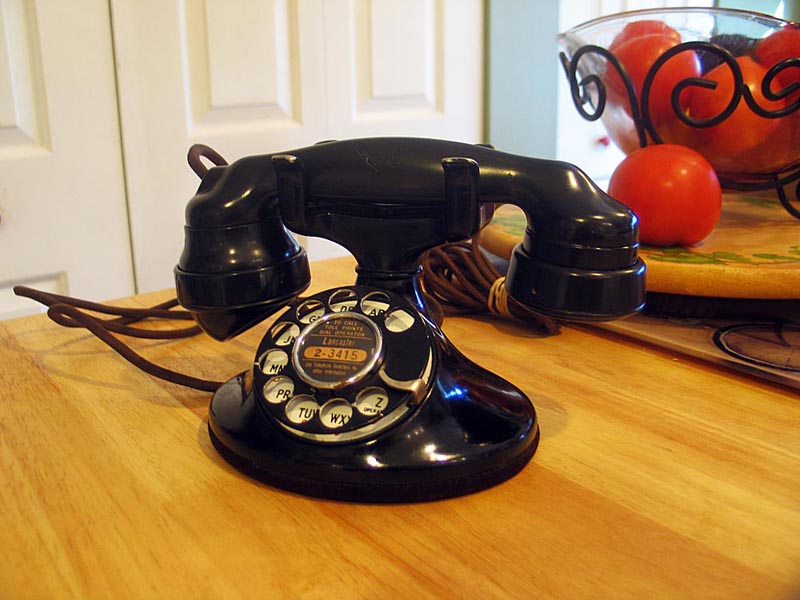 None of the components had matching dates, so I decided to take the best parts to put together one phone. So I ended up swapping the more desirable 4H dial for the 5H dial and mounting the E1 handset on the base at right, which had the best finish. Also the phone at right had good cloth covered cords for the handset and line.
None of the components had matching dates, so I decided to take the best parts to put together one phone. So I ended up swapping the more desirable 4H dial for the 5H dial and mounting the E1 handset on the base at right, which had the best finish. Also the phone at right had good cloth covered cords for the handset and line.
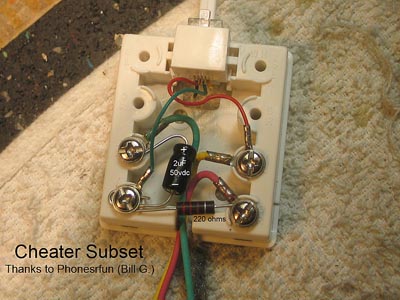 I cleaned and serviced both the 4H and 5H dials. I cleaned the handsets and bases with Simple Green, then polished and buffed the bases and handsets with Carnauba wax. I fully assembled the best set with the 4H dial and E1 handset.
I cleaned and serviced both the 4H and 5H dials. I cleaned the handsets and bases with Simple Green, then polished and buffed the bases and handsets with Carnauba wax. I fully assembled the best set with the 4H dial and E1 handset.
Since I didn't have a subset at the time to test the phone, I made a simple "cheater subset" as shown in the photo at left. The "cheater subset" goes between the phone and the house line. This allowed me to test the phone for talking and hearing and dialing. I also plugged the phone in to the house line and it worked properly, except there is no ringer.
1941 Western Electric Model 302 Desk Set
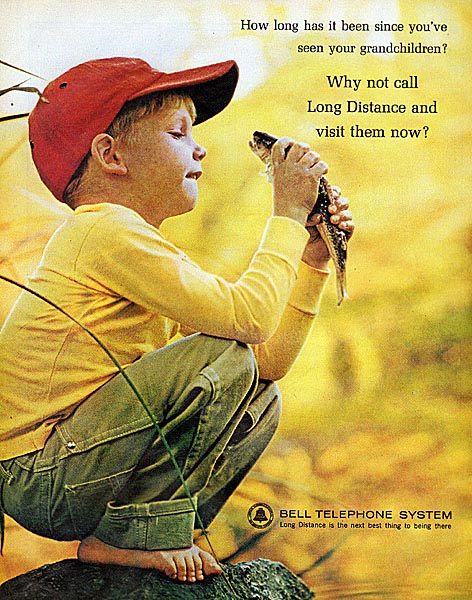 The Western Electric Model 302, introduced around 1937, was the first "modern" telephone, in that all the works were inside the telephone body--network, ringer, dialer, transmitter, and receiver. Earlier phones usually had the network and ringer in a separate box, called a subset or subscriber box, which was mounted in a different location than the phone.
The Western Electric Model 302, introduced around 1937, was the first "modern" telephone, in that all the works were inside the telephone body--network, ringer, dialer, transmitter, and receiver. Earlier phones usually had the network and ringer in a separate box, called a subset or subscriber box, which was mounted in a different location than the phone.
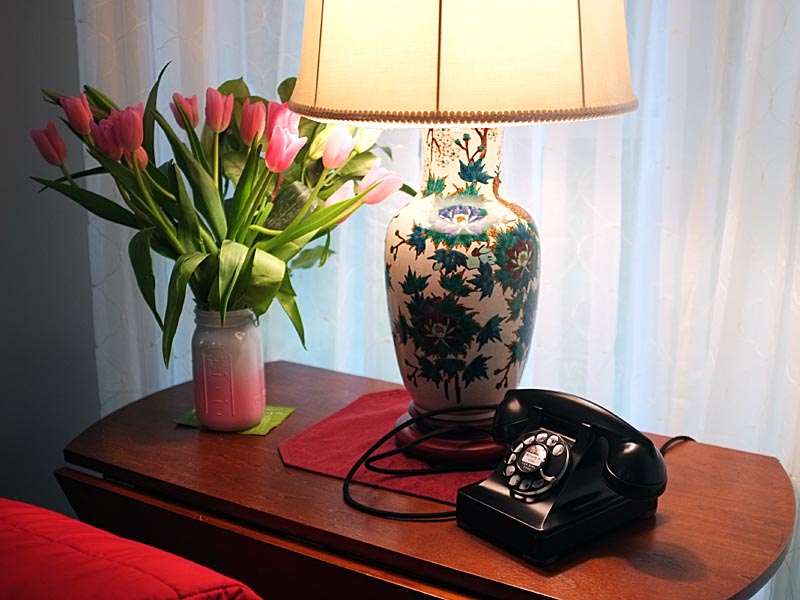 The Model 302 was designed by Henry Dreyfuss, who also designed the later model 500 that was used up into the 1980's. The pre-WWII Model 302 phones had metal bodies. Those made after the war had heavy thermoplastic bodies. Both versions are much heavier than modern phones.
The Model 302 was designed by Henry Dreyfuss, who also designed the later model 500 that was used up into the 1980's. The pre-WWII Model 302 phones had metal bodies. Those made after the war had heavy thermoplastic bodies. Both versions are much heavier than modern phones.
The telephone was in working condition when I found it, so electrical restoration consisted of cleaning and lubricating the dial mechanism, replacing the frayed handset cord and the missing line cord.
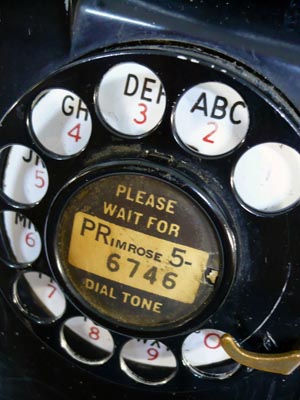
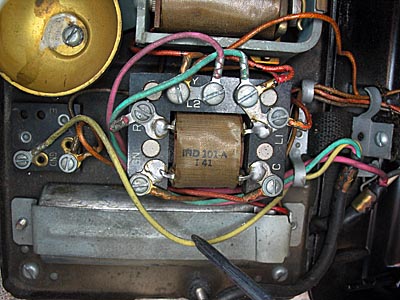
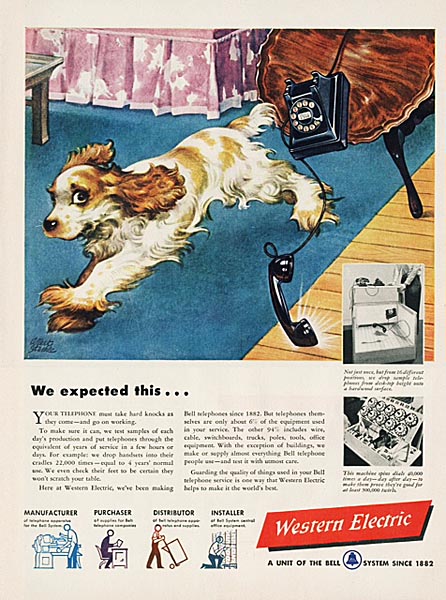
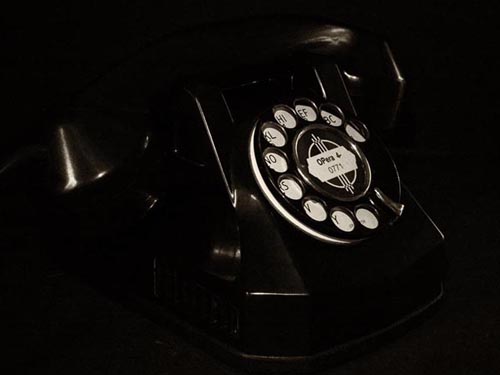 Late 1940's Automatic Electric Model 40 Desk Set
Late 1940's Automatic Electric Model 40 Desk Set
Introduced in 1940, the Automatic Electric Model 40 was a classic Art Deco styled desk telephone used by independent telephone companies in small urban and rural areas. Customers served by Ma Bell were issued the Western Electric Model 302 discussed above. The AE 40 was constructed of Bakelite. It was also available in a number of colors and trim options.
I found this example in an antique shop. The line cord and handset cord were unusable, and the dial was noisy and very rough, so I doubted the phone was in working. It was also quite dirty.
I also found out that, like most phones in small urban and rural areas, it was set up for use on a party line. This mean it had a frequency ringer that required a special frequency signal from the phone company so that other party line customers' phones wouldn't ring when this phone received a call. I had to replace the frequency ringer with a new ringer that would work on a standard private phone line. Changing the ringer also required putting in a new ringer capacitor, which is the yellow cylinder shown in the photo, center, below.
I disassembled the dial and cleaned it in an ultrasonic cleaner, then oiled it with clock oil. It worked much fast and smoother after than. I then reassembled the phone, installed a new handset cord and line cord and plugged it in. I had a dial tone and the phone rang when I called our number.
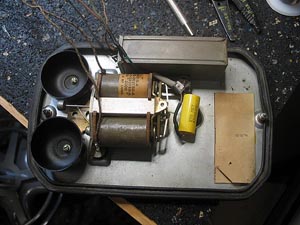

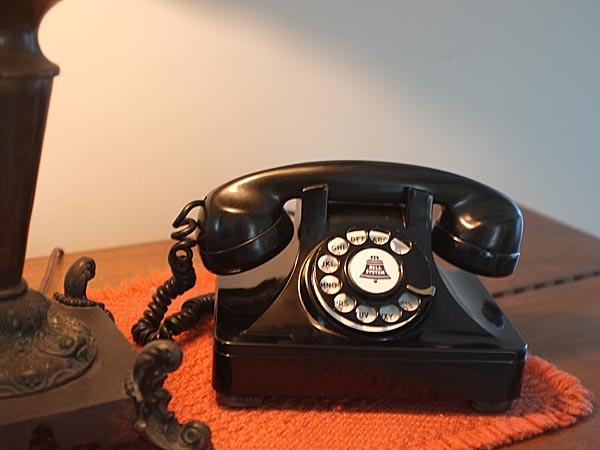 Early 1950's North Electric H270 "Galion" Desk Set
Early 1950's North Electric H270 "Galion" Desk Set
The North Electric phones are sometimes confused with Northern Electric telephones, which were telephones made in Canada by a Western Electric subsidiary. The North Electric Model H270, sometimes called the "Galion" is probably their most iconic model, and the nice Art Deco wide body design appears to have been copied by other manufacturers, and can also be found as fakes as well as modern reproductions.
 The example here, found on eBay, arrived is excellent condition. However, the phone had a party line ringer and therefore wouldn't ring on a standard POTS line. I had a Western Electric B1A ringer on hand, and found it would fit in place of the orginal North Electric ringer, so I swapped ringers (see photo, left). I had to drill one hole in the base plate to mount the WE ringer. Otherwise, the modification is reversible if needed.
The example here, found on eBay, arrived is excellent condition. However, the phone had a party line ringer and therefore wouldn't ring on a standard POTS line. I had a Western Electric B1A ringer on hand, and found it would fit in place of the orginal North Electric ringer, so I swapped ringers (see photo, left). I had to drill one hole in the base plate to mount the WE ringer. Otherwise, the modification is reversible if needed.
I cleaned and buffed the handset and shell with Novus 2. I cleaned the original coiled cord and re-used it. I installed a new modular line cord.
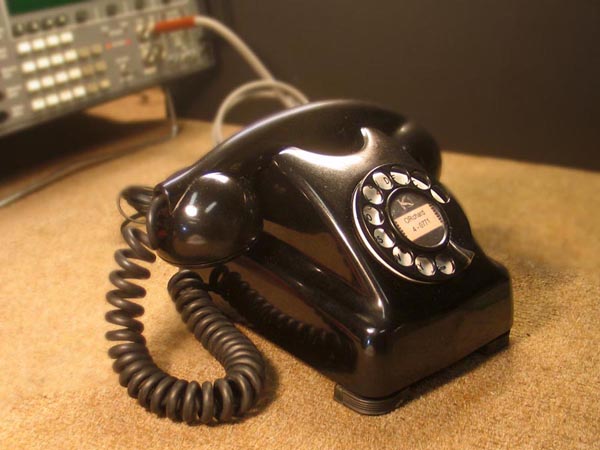 Circa 1948 Kellogg Model 1000 Masterphone "Red Bar" Desk Set
Circa 1948 Kellogg Model 1000 Masterphone "Red Bar" Desk Set
Kellogg made phones and switchboard equipment from the beginning of the telephone era in the late 19th century. The Kellogg 1000 was one of their first Post-WWII models, and was a nicely designed set with smooth contours. Mechanically, it was ahead of its time, featuring modular construction. The dial was plug-in, the capacitors and network wiring were sealed inside a block with terminals for the handset, ringer, and line connections, so there was no jumble of wires inside as with other telephones.
This set came from eBay for a very low price, depressed because the seller didn't bother to wipe off the dirt (Photo, below, right). Looking beyond the dirt, the phone seemed to me to be in very good cosmetic condition, with no cracks or chips in the shell.
 When it arrived, I did find a couple minor flaws. The center post holding the network block in place had snapped off, and one of the other screws securing the block was missing, so the block was loose, and the center post probably got broken during shipment. I reglued it with CA glue.
When it arrived, I did find a couple minor flaws. The center post holding the network block in place had snapped off, and one of the other screws securing the block was missing, so the block was loose, and the center post probably got broken during shipment. I reglued it with CA glue.
The other issue was a gummed up dial. The dial wouldn't return without help. Unfortunately, I could not break the screw loose that holds the fingerwheel in place, so I couldn't disassemble the dial to clean and lubricate it. I was afraid to apply too much force to the screw and risk damaging the dial. Instead, I squirted contact cleaner inside the dial from the backside of the dial. This got rid of most of the dried oils inside and the dial started working, although a little slow. I also applied some oil to the external pivot points I could access on the dial. The dial does work and will correctly dial out, even though it is not up to spec on speed.
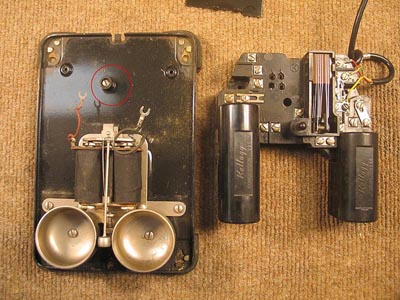 The remaining work was cleaning and buffing the handset and body. I used Simple Green to wash away the dirt on the coiled cord and body shell. After the shell dried, I buffed and polished it with Novus 2.
The remaining work was cleaning and buffing the handset and body. I used Simple Green to wash away the dirt on the coiled cord and body shell. After the shell dried, I buffed and polished it with Novus 2.
The reason this model is called the Kellogg "Red Bar" is due to the red plastic hookswitch, a unique design feature that many find appealing.
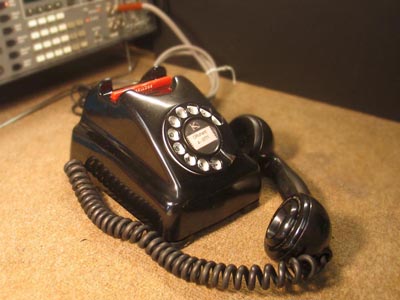
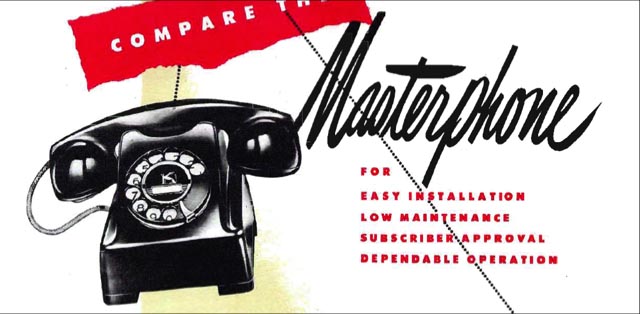
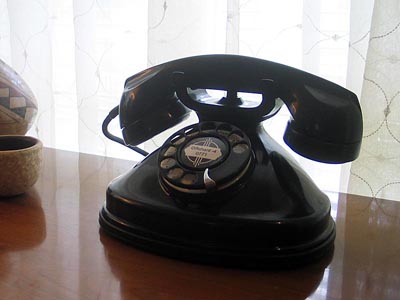 Stromberg-Carlson Model 1212ADH "Fatboy"
Stromberg-Carlson Model 1212ADH "Fatboy"
I found this very nice example of a Stromberg-Carlson Fatboy, Model 1212ADH, on eBay. Designed in the mid-1930's, the model 1212 phones were the first Stromberg-Carlson telephones to be self-contained, that is having a dial, ringer, and network all in one body. The phone was designed to resemble the popular Western Electric model 202, but had a larger shell to hold the network and ringer, which led to its being called the "Fatboy." The phones are somewhat scarcer than other phones of the era. I believe they were manufactured from the mid-1930's to the beginning of WWII.
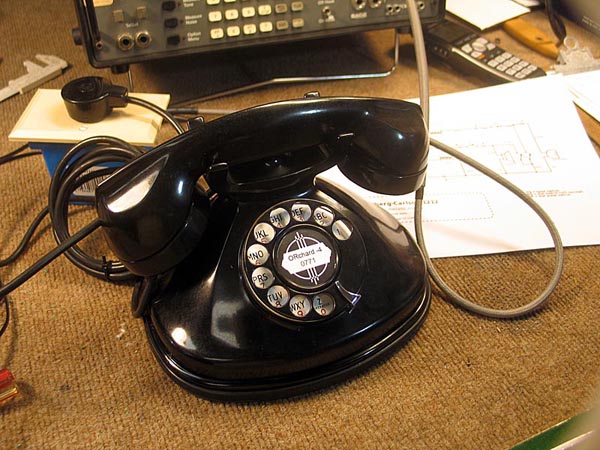 The telephone arrived in a relatively clean condition from the seller. The body and handset are free of scratches, chips, or other defects, and everything cleaned up nicely with Novus 2.
The telephone arrived in a relatively clean condition from the seller. The body and handset are free of scratches, chips, or other defects, and everything cleaned up nicely with Novus 2.
The phone was sold as untested, however I got a dial tone when I tested it, but no ring. I checked the ringer, and it's a 66.6 Hz ringer, which indicates it was used on a party line, not unusual at that time. I tested the ringer at 65 Hz, and it does work, with a very nice chime. I will swap it out for a straight line ringer if I ever find one.
Stromberg-Carlson did not make its own dials when this model first came out, and dials were either installed by SC upon a customer's request, or by the telephone company. Dials from Western Electric or Automatic Electric were often specified, and this one has an Automatic Electric dial installed. I removed the AE dial, cleaned and oiled it, and replaced the dial card and lens with one I made. The handset cord was badly dry-rotted, so I replaced it with another I had on hand. The line cord was in good condition. The rubber bumper around the bottom is somewhat brittle, so I did not try removing it.
I was favorably impressed with the build quality of the phone, and it works very well, with good audio quality. If I can find the correct ringer for it, it would make a nice everyday phone, at least until Verizon stops providing POTS service in my area.
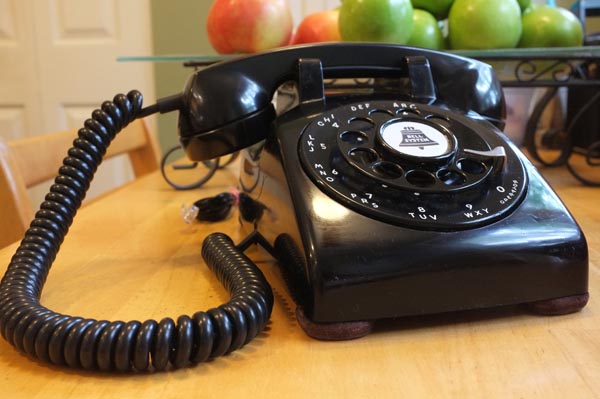 1954 Western Electric Model 500 C/D with Metal Finger Wheel
1954 Western Electric Model 500 C/D with Metal Finger Wheel
In the late 1940's Western Electric began design and development work on a new telephone desk set to replace the Model 302, shown at the top of this page. By 1950, Western Electric was issuing the new phone, designated the Model 500. This model was the last rotary dial Western Electric home desk set model, and millions of 500 series phones remained in service until divestiture in the 1980's. Early models, such as the one shown here, had a metal finger wheel, which was replaced with a clear plastic finger wheel in later versions.
I found this Western Electric 500 C/D with metal finger wheel in an antique store in Egg Harbor, WI. Other than some dirt, a few scratches, and a kinked and cracked handset cord, it looked pretty good.
The phone actually worked, in spite of a rotten handset cord. I found a new handset cord, and while waiting for it to arrive, I cleaned the base of dust and debris, and polished and buffed the handset and shell with Novus #2. The dial card had the phone number from Wisconsin, and when I went to replace it, under the one showing, I found the original, with a JAckson exchange. I also replaced the original line cord with standard 4-prong plug with a modular cord and plug.
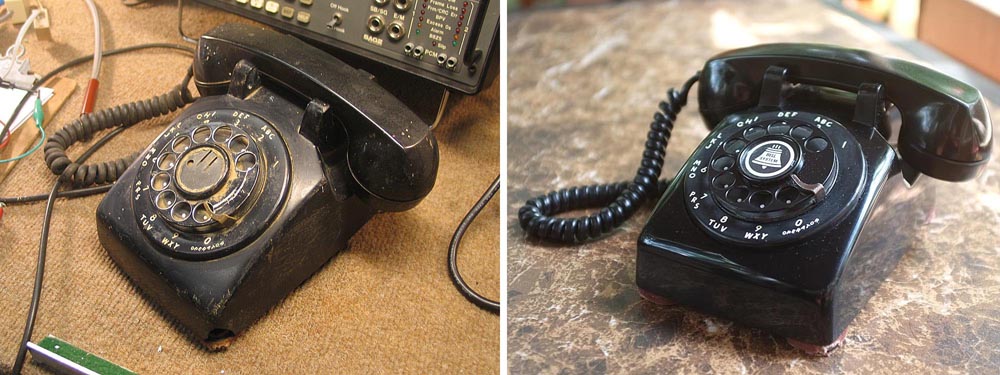 1958 Western Electric Model 5302G Desk Set
1958 Western Electric Model 5302G Desk Set
Western Electric products were extremely reliable, and the Bell System found itself with millions of serviceable 300 series phones and replacement parts following introduction of the Model 500. Being a very frugal and well managed company, Bell designed a thermoplastic shell than looked like a 500 series phone, but was actual made to fit on a 300 series base and use 300 series parts.
Beginning around 1955, Bell began issuing these hybrid phones to customers. Although the phone looked very much like a modern Model 500 set, it was really just a 1930's technology Model 302 in a 500 styled shell. Bell called it the Model 5302. Bell produced these phones through 1964, by which time they had presumably exhausted their supply of 302 parts.
I paid less than $10.00 for this phone, and the reason for the low price is obvious from the "before" picture above. The shell, or body, of the phone was beyond repair. In addition to the chip in the right front, there were deep gouges in the right side, and dial mount was cracked. So I junked the original body and found a used one. All the other components came from the $10.00 junker after a thorough cleaning. The phone actually worked when I got it, so other than cleaning and lubricating the dial mechanism, restoraton was just a lot of cleanng and polishing.
This particular phone came with the upgraded G1 handset. However, the transmitter and receiver elements are both 302 elements. Some G1 handsets did come with upgraded elements. Also some Model 5302 phones were issued with Model 302 F1 handsets. Like the 500 series phones, the 5302 did have a loudness control for the ringer.
 1967 Western Electric Model 500 with Plastic Finger Wheel
1967 Western Electric Model 500 with Plastic Finger Wheel
This is a very nice yellow Western Electric Model 500C/D from 1967. It also works very well, and is now our bedside phone.
The phone had a standard four-pin telephone plug, they type that pre-dated the modular plugs used now. I wanted to keep the round yellow line cord, so I replaced the four-pin connector with a modular phone jack, which requires using a little modular pigtail to connect to the wall jack.
Other than that, this phone only required some cleaning and polishing.
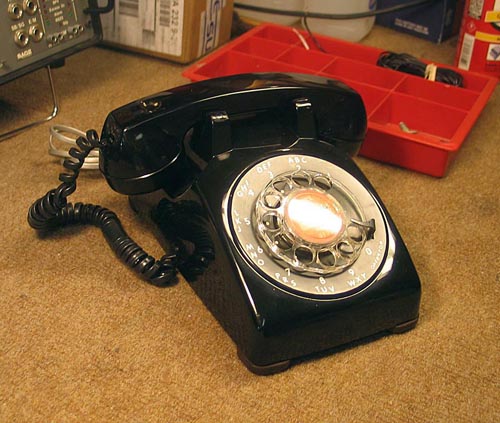 1961 Stromberg-Carlson/Western Electric Signal Corps Telephone
1961 Stromberg-Carlson/Western Electric Signal Corps Telephone
I found this phone and two others shown below at an antique mall. This phone turned out to be somewhat of a mystery phone. The shell and handset are Stromberg-Carlson manufacture, but the phone is mounted on a Western Electric type 500 baseplate, but with a U.S. Army Signal Corps part number.
The phone is operational, and just needed a polishing. However, its provenance is suspect. Did the Signal Corps put this phone together from SC and WE parts, or did someone else create a Frankenphone from various parts? It is, however, a nice working phone, whatever its origins.
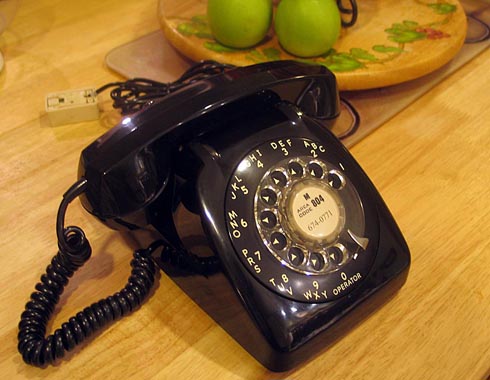 1968 Automatic Electric Model 80 Desk Set
1968 Automatic Electric Model 80 Desk Set
The Automatic Electric Model 80 phone shown here was originally a party line phone, as the ringer is a 50 Hz ringer, so it won't ring on a standard POTS landline. I could try and find a straight line, or 20 Hz ringer, but since I don't plan to use the phone on a regular basis, I may just leave it as is. Otherwise, the phone works well, and required only some cleaning and polishing.
Japanese JN-4 Reproduction "French Telephone"
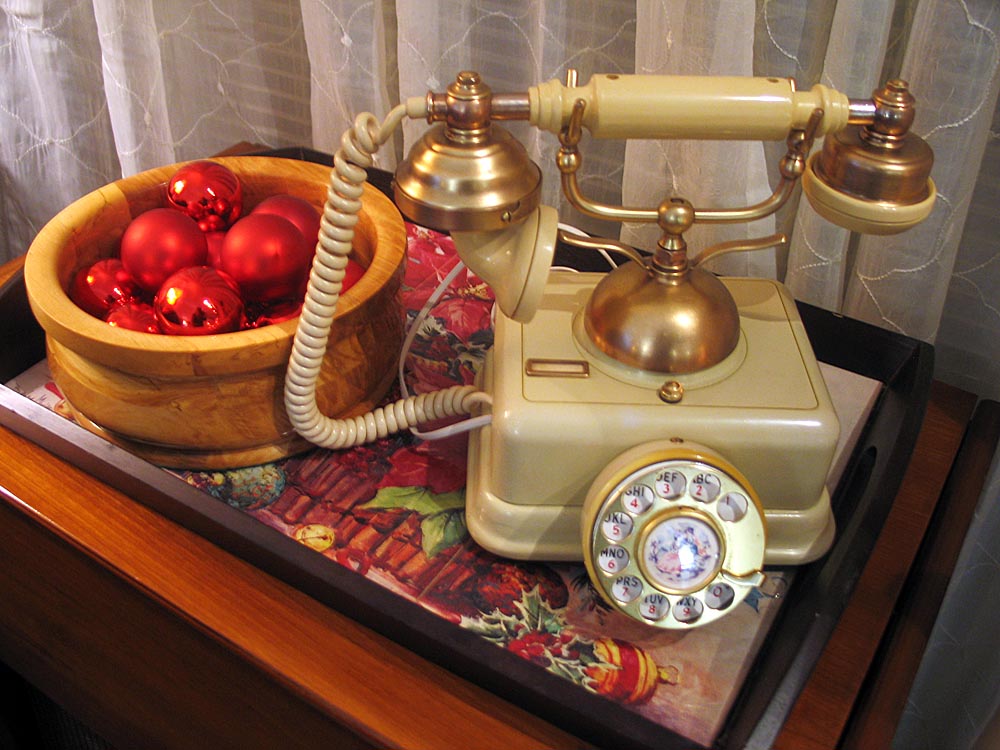
The reproduction "French Telephone" shown here is actually a reproduction of an early 20th century Danish telephone. This model has been reproduced both in Japan and Korea for the US market.
The Japanese JN-4 reproduction used genuine Western Electric parts. Unfortunately, mine, which was given to me, had been stripped of the network and ringer. The receiver and transmitter elements were present in the handset, and the hookswitch and dialer were present.
I learned through research on the Classic Rotary Telephones forum that I could use the network and ringer from a Princess 702B telephone. I found one at Goodwill for less than $10.
I mounted the network and ringer from the Princess phone on the base of the JN-4, as shown in the second photo. The network mounted perfectly to the existing screw holes, but I had to adapt the Princess ringer as the Western Electric ringer originally used in the JN-4 was the type used in Trimline phones, so the ringer mount didn't match up. But modifying the Princess ringer was fairly simple.
When I got everything assembled, the JN-4 could ring and answer calls, but wouldn't dial out correctly. Cleaning and lubricating the dial didn't help. I temporarily wired in the dial from the Princess phone, and it worked properly. However, I couldn't use it as it wouldn't fit in the JN-4 dial housing. Luckily, I found a new old stock Western Electric 6U dial, an exact replacement for the non-working original dial, on eBay. I purchased it and swapped it out for the bad dial, and now the phone works as it should.

1964 Stromberg-Carlson 1545W Desk Set
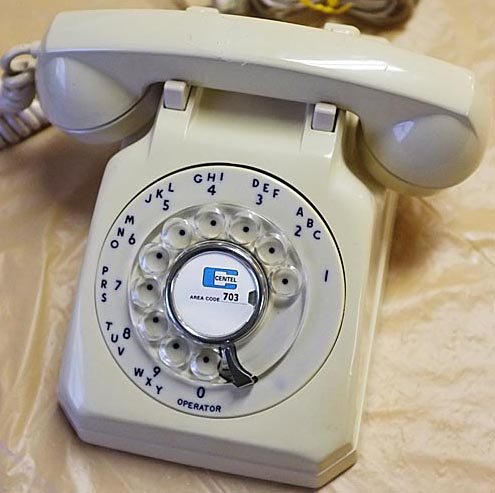
I found this nice SC1546W ivory desk set in an antique store in southwest Virginia. It was "on sale" at $25, which is a pretty good price for a rotary desk set around here.
But I think the Stromberg-Carlson 1546W is a little rarer the the usual Western Electrics, and I like the chopped corners. Everything was complete and appears to be all original. The phone was very clean. There was a little Scotch tape residue on handset I had to clean off.
When I got home, my assistant Zeke and I checked out the phone. Everything works great! Dial tone, rotary dial works fine, standard ringer works. Actually my assistant isn't much help; he just gets in the way.
 The network is marked 206011-409. The receiver is dated 2-65 and the only other marking is a "33." The transmitter is dated 9-64 and marked "30"
The network is marked 206011-409. The receiver is dated 2-65 and the only other marking is a "33." The transmitter is dated 9-64 and marked "30"
I replaced the line cord with a new cord with a more modern small RJ11 plug, as the original had a large, rectangular modular plug attached that was rather awkward to use. The original line cord was a two wire cord.
1983 Western Electric Model 2500 DMG Desk Set
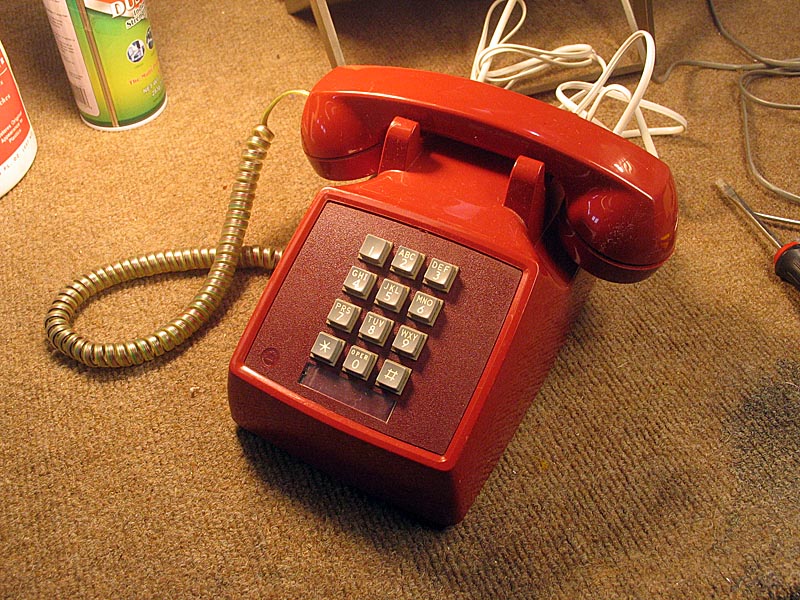
I don't usually buy Model 2500 phones, but when I saw a red one in an antique store for a hard to believe $10, I couldn't pass it up. It had no line cord or handset cord, and I figured something else must be wrong to be so cheap. Cosmetically, the phone was in very good condition. I figured for $10, I could at least get parts from it.
When I got it home, I installed a line cord and handset cord and connected to the phone line. No dial tone. So I dragged out the BK 1045. The keypad checked out as did the voice level. I connected another phone and I could tell the transmitter was OK.
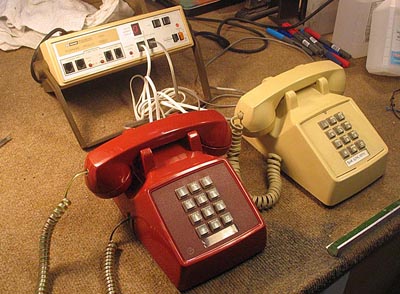 So I pulled the receiver out of the handset. Didn't see anything wrong, and put it back. Check again and I had a dial tone. Still not sure what was wrong with receiver to begin with. Anyway, everything works now, so I cleaned up the shell and handset with alcohol and Novus.
So I pulled the receiver out of the handset. Didn't see anything wrong, and put it back. Check again and I had a dial tone. Still not sure what was wrong with receiver to begin with. Anyway, everything works now, so I cleaned up the shell and handset with alcohol and Novus.
Although the manufacture date appears to be 1983, the network, ringer, and keypad are dated 1982, the receiver dates from 1967, and the transmitter from 1965.



 I found this very nice example of a 1970's Western Electric payphone for $10 at a yard in September, 2017. It came without a key for the upper housing, where all the telephone circuitry is located. The lower housing, which contains the coin vault and return did not have a lock. The lock had been removed and the coin vault was missing.
I found this very nice example of a 1970's Western Electric payphone for $10 at a yard in September, 2017. It came without a key for the upper housing, where all the telephone circuitry is located. The lower housing, which contains the coin vault and return did not have a lock. The lock had been removed and the coin vault was missing. Western Electric introduced the first candlestick styled desk stand telephone sets in 1904. The 20AL model shown here was introduced in 1915. The telephones were made of brass, and beginning around 1910, were painted black. Earlier models were brass or nickel plated.
Western Electric introduced the first candlestick styled desk stand telephone sets in 1904. The 20AL model shown here was introduced in 1915. The telephones were made of brass, and beginning around 1910, were painted black. Earlier models were brass or nickel plated. I decided to leave the dial card holder brass instead of painting it black, so to provide some visual interest to the telephone. I added an original number card I had on hand. I also used a Dremel brush to remove the black paint from the copper builder's place under the mouthpiece, again for some aesthetic appeal.
I decided to leave the dial card holder brass instead of painting it black, so to provide some visual interest to the telephone. I added an original number card I had on hand. I also used a Dremel brush to remove the black paint from the copper builder's place under the mouthpiece, again for some aesthetic appeal. I found these two Western Electric Model 202 desk sets on the Goodwill online auction site. I was lucky enough to win both. The set on the left in the photo at left has an E1 handset and a 4H dial. The 4H dial was the last dial made by Western Electric that had a "clickety-clack" sound as the dial returns to its stop. The set on the right has a 5H dial and F1 handset. Both are correct as Western Electric evolved the various components used in the set, which was produced from about 1928 to the mid-1940's. The sets were re-issued in the 1950's with chrome and gold bases as "designer" sets.
I found these two Western Electric Model 202 desk sets on the Goodwill online auction site. I was lucky enough to win both. The set on the left in the photo at left has an E1 handset and a 4H dial. The 4H dial was the last dial made by Western Electric that had a "clickety-clack" sound as the dial returns to its stop. The set on the right has a 5H dial and F1 handset. Both are correct as Western Electric evolved the various components used in the set, which was produced from about 1928 to the mid-1940's. The sets were re-issued in the 1950's with chrome and gold bases as "designer" sets. None of the components had matching dates, so I decided to take the best parts to put together one phone. So I ended up swapping the more desirable 4H dial for the 5H dial and mounting the E1 handset on the base at right, which had the best finish. Also the phone at right had good cloth covered cords for the handset and line.
None of the components had matching dates, so I decided to take the best parts to put together one phone. So I ended up swapping the more desirable 4H dial for the 5H dial and mounting the E1 handset on the base at right, which had the best finish. Also the phone at right had good cloth covered cords for the handset and line. I cleaned and serviced both the 4H and 5H dials. I cleaned the handsets and bases with Simple Green, then polished and buffed the bases and handsets with Carnauba wax. I fully assembled the best set with the 4H dial and E1 handset.
I cleaned and serviced both the 4H and 5H dials. I cleaned the handsets and bases with Simple Green, then polished and buffed the bases and handsets with Carnauba wax. I fully assembled the best set with the 4H dial and E1 handset. The Western Electric Model 302, introduced around 1937, was the first "modern" telephone, in that all the works were inside the telephone body--network, ringer, dialer, transmitter, and receiver. Earlier phones usually had the network and ringer in a separate box, called a subset or subscriber box, which was mounted in a different location than the phone.
The Western Electric Model 302, introduced around 1937, was the first "modern" telephone, in that all the works were inside the telephone body--network, ringer, dialer, transmitter, and receiver. Earlier phones usually had the network and ringer in a separate box, called a subset or subscriber box, which was mounted in a different location than the phone. The Model 302 was designed by Henry Dreyfuss, who also designed the later model 500 that was used up into the 1980's. The pre-WWII Model 302 phones had metal bodies. Those made after the war had heavy thermoplastic bodies. Both versions are much heavier than modern phones.
The Model 302 was designed by Henry Dreyfuss, who also designed the later model 500 that was used up into the 1980's. The pre-WWII Model 302 phones had metal bodies. Those made after the war had heavy thermoplastic bodies. Both versions are much heavier than modern phones.


 Late 1940's Automatic Electric Model 40 Desk Set
Late 1940's Automatic Electric Model 40 Desk Set

 Early 1950's North Electric H270 "Galion" Desk Set
Early 1950's North Electric H270 "Galion" Desk Set The example here, found on eBay, arrived is excellent condition. However, the phone had a party line ringer and therefore wouldn't ring on a standard POTS line. I had a Western Electric B1A ringer on hand, and found it would fit in place of the orginal North Electric ringer, so I swapped ringers (see photo, left). I had to drill one hole in the base plate to mount the WE ringer. Otherwise, the modification is reversible if needed.
The example here, found on eBay, arrived is excellent condition. However, the phone had a party line ringer and therefore wouldn't ring on a standard POTS line. I had a Western Electric B1A ringer on hand, and found it would fit in place of the orginal North Electric ringer, so I swapped ringers (see photo, left). I had to drill one hole in the base plate to mount the WE ringer. Otherwise, the modification is reversible if needed. Circa 1948 Kellogg Model 1000 Masterphone "Red Bar" Desk Set
Circa 1948 Kellogg Model 1000 Masterphone "Red Bar" Desk Set When it arrived, I did find a couple minor flaws. The center post holding the network block in place had snapped off, and one of the other screws securing the block was missing, so the block was loose, and the center post probably got broken during shipment. I reglued it with CA glue.
When it arrived, I did find a couple minor flaws. The center post holding the network block in place had snapped off, and one of the other screws securing the block was missing, so the block was loose, and the center post probably got broken during shipment. I reglued it with CA glue. The remaining work was cleaning and buffing the handset and body. I used Simple Green to wash away the dirt on the coiled cord and body shell. After the shell dried, I buffed and polished it with Novus 2.
The remaining work was cleaning and buffing the handset and body. I used Simple Green to wash away the dirt on the coiled cord and body shell. After the shell dried, I buffed and polished it with Novus 2.

 Stromberg-Carlson Model 1212ADH "Fatboy"
Stromberg-Carlson Model 1212ADH "Fatboy" The telephone arrived in a relatively clean condition from the seller. The body and handset are free of scratches, chips, or other defects, and everything cleaned up nicely with Novus 2.
The telephone arrived in a relatively clean condition from the seller. The body and handset are free of scratches, chips, or other defects, and everything cleaned up nicely with Novus 2. 1954 Western Electric Model 500 C/D with Metal Finger Wheel
1954 Western Electric Model 500 C/D with Metal Finger Wheel 1958 Western Electric Model 5302G Desk Set
1958 Western Electric Model 5302G Desk Set 1967 Western Electric Model 500 with Plastic Finger Wheel
1967 Western Electric Model 500 with Plastic Finger Wheel 1961 Stromberg-Carlson/Western Electric Signal Corps Telephone
1961 Stromberg-Carlson/Western Electric Signal Corps Telephone 1968 Automatic Electric Model 80 Desk Set
1968 Automatic Electric Model 80 Desk Set


 The network is marked 206011-409. The receiver is dated 2-65 and the only other marking is a "33." The transmitter is dated 9-64 and marked "30"
The network is marked 206011-409. The receiver is dated 2-65 and the only other marking is a "33." The transmitter is dated 9-64 and marked "30"
 So I pulled the receiver out of the handset. Didn't see anything wrong, and put it back. Check again and I had a dial tone. Still not sure what was wrong with receiver to begin with. Anyway, everything works now, so I cleaned up the shell and handset with alcohol and Novus.
So I pulled the receiver out of the handset. Didn't see anything wrong, and put it back. Check again and I had a dial tone. Still not sure what was wrong with receiver to begin with. Anyway, everything works now, so I cleaned up the shell and handset with alcohol and Novus.